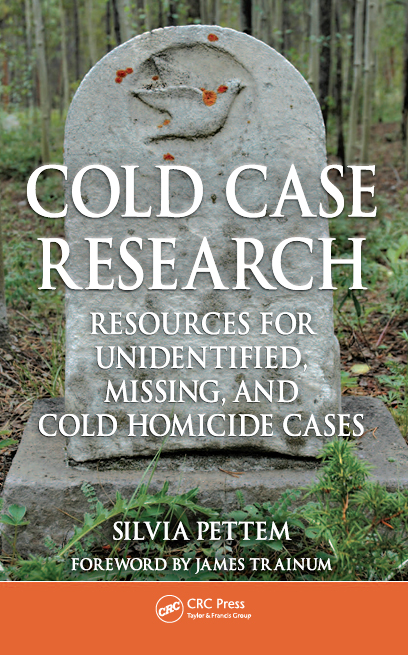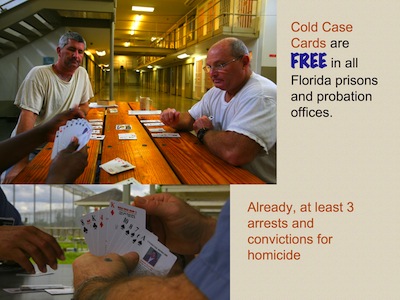
HOME | BOOKS | ARTICLES | BIOGRAPHY | PRESENTATIONS | JANE DOE/DOROTHY | LINKS | CONTACT
 Unknown gravestone in the Evergreen Cemetery, Leadville Colorado Unknown gravestone in the Evergreen Cemetery, Leadville Colorado |
COLD CASE RESEARCH
RESOURCES FOR UNIDENTIFIED, MISSING, AND COLD HOMICIDE CASES "For the investigator, Pettem’s work will undoubtedly jump-start many a stalled investigation and keep others moving forward. For cold case unit managers, it opens up a world of new opportunities––the opportunity to expand the capacities of their units, take advantage of free resources, and to institute changes that address the outdated attitudes, policies, and procedures that, in the past, prevented some cases from being solved." |
|
In the UK publication The Police Journal, Vol. 85 #2, Cheryl Allsop, Lecturer of Criminology and Criminal Justice at University of Glamorgan, writes, "The literature on cold case investigations tends to fall into two genres; practical resources for cold case investigators or true crime public interest books dramatically depicting unsolved murders for an interested public. While this book falls firmly into the former category, designed to be a useful resource for cold case detectives, it nevertheless also manages to successfully straddle the latter camp, by providing interesting case study examples of cold case investigations and investigations into missing persons and the ‘unidentified dead.’ It is this mix of practical resources and vivid case study examples that sets this book apart from other similar texts." Read the rest of her review here. Cases in which all investigative leads appear to be exhausted are frustrating for both investigators and victims’ families. Cold cases can range from those only a few months old to others that go back for decades. Presenting profiles and actual case histories, Cold Case Research: Resources for Unidentified, Missing and Cold Homicide Cases illustrates how investigators can successfully apply resources that will enable them to reopen and solve cases gathering dust in the file room. Today’s investigators have found that, to solve cold cases, they need to be internet savvy and make the best use of the rapidly changing methodologies of the twenty-first century, but they also have to be time travelers and open the door to the past. This volume weaves together the nearly forgotten skill sets of traditional historical researchers with the latest online tools, including TLO, a premier investigative system; and NamUs, the revolutionary dual databases for missing persons and unidentified remains. Along with practical applications, Cold Case Research gives investigators the tools they need to save time and money and to jump-start their cold cases, while keeping others from going cold in the future. Topics discussed include: · Implementing cold case units · People searches and working with databases · Overlooked DNA in PKU cards · The plight of the missing and unknown · Applying historical and geographical context · Online and off-line newspaper research · Public and published records · The use of volunteers · Contact with co-victims · Cold-case review teams and information-sharing resources · Taking advantage of the media Using a thinking-outside-the-box approach, this volume helps fill major gaps in traditional cold case investigation training and techniques, enabling investigators to confidently reopen and crack the mysteries of cases long thought unsolvable. 
Sample slides (on right)
Power-point presentation on Cold Case Research. Please contact Silvia Pettem to schedule a presentation at your agency.
Oct. 14/15, 2014, New Jersey Chapter IAI, Hamilton NJ ((combined with Someone's Daughter)
Nov, 2014, Tri-State IAI, Phoenix AZ (combined with Someone's Daughter) Customer reviews: ABOUT THE AUTHOR– Silvia Pettem is a longtime historical researcher, newspaper columnist, and author of more than a dozen books. After decades of work for individuals, businesses, and governments, her life took a new turn in 1996, when she stumbled upon the gravestone of a Jane Doe––a murder victim from 1954. A few years later, Pettem applied her research skills to both old-fashioned detective work and the power of the internet by entering into a partnership with her local sheriff and with forensic experts of the Vidocq Society to successfully determine the young woman’s identity. Pettem chronicled their work in Someone’s Daughter: In Search of Justice for Jane Doe. In 2008, the Boulder County Sheriff’s Office gave Pettem a Sheriff’s Commendation Award for doing the “lion’s share of the research” on the Jane Doe case. Two years later, the Vidocq Society presented her with its Medal of Honor. Pettem is now an associate member of the Vidocq Society, a volunteer in the Detectives Section of the Boulder Police Department, a NamUs Academy graduate, and a NamUs instructor in classes sponsored by the Colorado Bureau of Investigation––expanding her expertise and working with colleagues all over the country. She wrote Cold Case Research: Resources for Unidentified, Missing, and Cold Homicide Cases in order to aid other investigators as they grapple with cold cases of their own. FOR THE MEDIA (and others): 
"Like" us on FACEBOOK. Cases of the murdered, missing, and unidentifed. Take a look and join the discussions.
NEW - January 2013, U.S. SUPREME COURT AMICUS CURIAE, Law Enforcement Officers Working Difficult-to-Investigate Crimes Often Rely on the Passage of Time. November 16, 2012, Interview with Cold Case Author and Historian Silvia Pettem, forensics4fiction blog by Tom Adair September 16, 2012, Cold Case Research is the "featured" book on Lieutenant Foster's Author 411 site today. August 23, 2012, Using Media to Warm Cold Cases, Forensics For Writers blog. July/August 2012, "Using the Media in Cold Case Research," Evidence Technology Magazine. In Kristi Mayo's editorial, "It's Been There the Whole Time," she states, "Cold-case research expert Silvia Pettem explains how utilizing the media can help investigators find people and bits of information that, of course, always existed… except the people who had the information were not aware that someone wanted to know." June 18, 2012 –– "Justice for Joe: Hope for the Missing and Unidentified," Defrosting Cold Cases blog June 2012, "Silvia Solves Cold Cases," Boulder Police Department SPOTLIGHT, page 3. May 1, 2012 –– See excerpt on Detective Ron Lopez––"Colorado Detective's Persistance Pays Off––at the Cold Case Squad blog. VIDOCQ SOCIETY JOURNAL, Spring 2012, includes "Vidocq Society a resource in new book, Cold Case Research." GUEST BLOG POSTS INCLUDE EXCERPTS FROM COLD CASE RESEARCH: February 10, 2012, Defrosting Cold Cases Blog, Update Silvia Pettem's new book January 29, 2012, Unit at CSPD finds answers for families of missing persons, The Gazette, Colorado Springs, Colorado, by Maria St. Louis-Sanchez. |
|